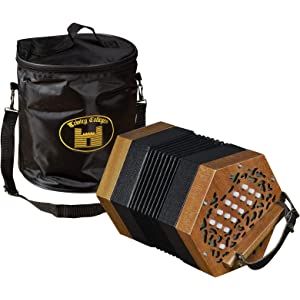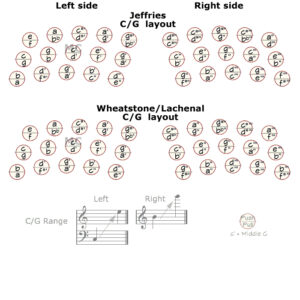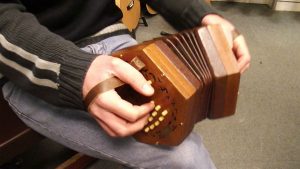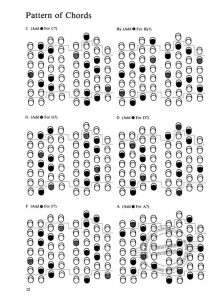Charles Wheatstone first designed and constructed his concertina in 1829; this free-reed instrument features bellows that expand and contract, along with buttons at either end to push air through its reeds to produce sound.
The concertina is an esoteric chromatic instrument capable of playing in many keys. English system trebles span three and one half octaves while baritones transpose down one octave for baritone players.
Keys
The concertina is a squeezebox instrument which uses push-pull action to play notes. As this instrument is diatonic, pushing or pulling each button plays different notes when played.
Standard 48 key English concertinas have an instrument range that spans from G below middle C up to three octaves above middle C – equivalent to that of violins.
There are two primary varieties of concertina: English and Anglo. If necessary, specialist concertina makers can tailor-make one in the key of your choice.
Anglo concertinas differ from their English counterparts in their key arrangement; Anglo concertinas utilize a “bisonoric” system whereby pushing or pulling produces different notes.
Wheatstone and Jeffries are two key anglo concertina layouts. Both differ primarily in their note layout of the right hand accidental row; with Jeffries offering more buttons that enable beginners to play melodies in both treble and bass clefs more easily.
Layouts
There are multiple layouts of 30 key concertina, some more common than others. All share similar bellows and buttons at either end, yet can differ in terms of function of keys.
Contrary to its piano counterpart, Anglo concertinas produce distinct notes with each push and pull of its bellows, depending on which button is pressed and whether one pushes or pulls. This diatonic nature contributes to their popularity as one of many instruments available today.
They can also be played in keys other than their home key, making it easier to play together or experiment with different styles; however, this makes tuning and learning new music more challenging.
Wheatstone and Jeffries are two commonly utilized layouts of the 30-key Anglo, distinguished by differences in note placement in their right-hand accidental row and by variations in number and location of “helper” notes to accommodate playing in keys outside your usual key range.
Reeds
Concertina reeds differ significantly from accordion reeds in several ways, most significantly because their beveled edges fit snugly within their window yet swing out when being played, providing greater dynamic range than accordion windows’ vertical walls.
Concertina reeds are made of wax, while accordions typically use steel. This allows different stiffness levels ranging from very light for lower reeds all the way up to thick clamp ends with thin tips in high reeds for improved tone quality.
A 30-key concertina features two rows of keys in C and G (its home keys), as well as an additional row of accidentals spread among its outer rows. This gives it an extended range and makes it suitable for playing music beyond its home keys; particularly suitable for Irish and ragtime tunes.
Case
The 30 key concertina is a three row instrument and an ideal way to begin learning to play concertina quickly. Reliable yet simple to learn on, its simple tuning system ensures beginners progress quickly towards becoming accomplished players.
An Anglo 30 button concertina covers the range from G below middle C to C two octaves higher, making its range similar to that of violins. Although typically found as treble concertinas, baritone and bass versions may also be purchased.
It is a fully chromatic instrument, featuring two central rows on either side in C, with accidentals distributed among its outer rows. Each button can be played simultaneously by both hands for easy scale playing or melodies.
Minstrel bands and music hall performers utilized it extensively as a vamping instrument during the nineteenth century, with tutors such as Roylance and Booth emphasizing its use to accompany songs or dance performances onstage or for dance events.




